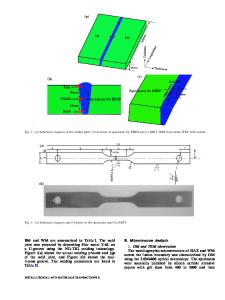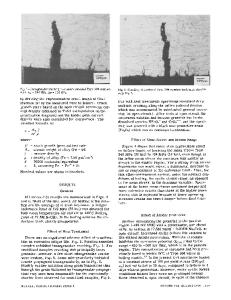Atmospheric Stress Corrosion Cracking (ASCC) Susceptibility of Stainless Alloys for Metallic Containers
- PDF / 208,729 Bytes
- 8 Pages / 612 x 792 pts (letter) Page_size
- 10 Downloads / 341 Views
Atmospheric Stress Corrosion Cracking (ASCC) Susceptibility of Stainless Alloys for Metallic Containers Gen NAKAYAMA Research Laboratory, Ishikawajima-Harima Heavy Industries, Co., Ltd. 1、Shin-Nakahara-Cho, Isogo-ku, Yokohama 235-8501, Japan ABSTRACT Metallic canisters placed in concrete casks and containing spent nuclear fuel elements, will be exposed to a moist oceanic atmosphere while the decay heat generated in the fuel elements cools for more than fifty years. Thus, the surface environment of the metallic canisters will be wet and covered with chloride compounds. The canisters may suffer atmospheric stress corrosion cracking. Therefore, corrosion tests for some potential alloys were conducted in an aqueous bittern solution, containing 22% enriched chloride compounds simulating the expected surface conditions of the canisters, to aid in selecting appropriate alloys based on corrosion resistance. The results suggest that the corrosion resistance of ordinary stainless steels, such as SUS304 and SUS316, is not high enough to avoid ASCC (atmospheric stress corrosion cracking) in the environment. Thus, a higher-grade stainless steel, namely, NSSC270 (20Cr-18Ni-6Mo-0.2N-Low C) or SUS836L (23.5Cr-25Ni-5.5Mo-0.2N-Low C, equivalent to AL-6XN) has been selected for this application. GENERAL DESCRIPTION OF CONCRETE CASK SYSTEM The concrete cask system [1] is one of the systems used to store spent nuclear fuel elements discharged from light water nuclear reactors, before they are utilized in recycling processes. Nuclear fuel elements will be stored in a metallic container, called a canister, and the canister will be stored in a cask made of reinforced concrete shown in Figure 1. A geological disposal system developed in Japan may be constructed along a shoreline and therefore the corrosion behavior of the candidate alloys in marine exposure conditions was analyzed during the design phase.
Spent Nuclear Fuel Metallic Container
Concrete Cask
Humid Oceanic Cooling Air
Figure 1 Schematic view of the concrete cask system[1]. Spent nuclear fuel elements (equivalent to 21 PWR fuel rods) will be placed in a latticework in an inner bucket in the canister, to avoid a critical mass developing. Release of radioactive materials from the canister will be prevented by seal-welding the canister and by employing a double-lid type
structure. Furthermore, inert gas will be sealed inside the canister to maintain the spent nuclear fuel in good condition. Any radiation emitted from the spent fuel elements will be shielded mainly by the thick-walled concrete cask. The decay heat released from the spent fuel elements will be removed by natural convection. The convective flow will be from the inlet located at the bottom to the outlet located top ends of the concrete cask respectively, through the annular space between the inner surface of the cask body and the outer surface of the metallic canister. ENVIRONMENTAL CONDITIONS AND PROBLEMS IN SELECTING CANDIDATE ALLOYS The surface of the canister will be heated by the fuel decay process to tempe
Data Loading...











